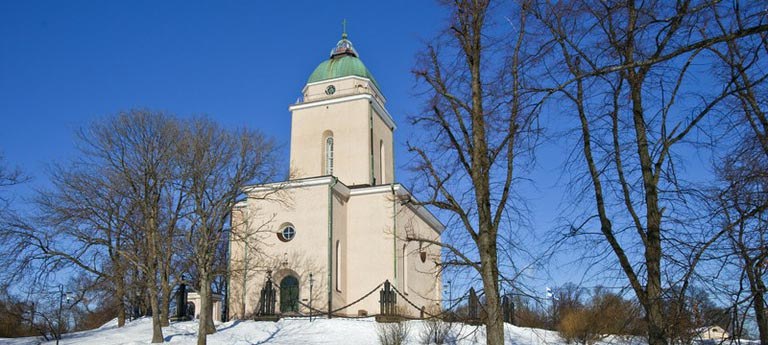Suomenlinna church

The construction of the Viapori fortification began in 1748. Despite the intentions, the church designed by the Swedish architect, Carl Hårleman, was not built, because the completion of the fortifications was seen as having primary importance. However, the Susisaari fortifications had room for a church, and the small wooden church of the island is mentioned in travellers' journals in 1785.
After Sweden lost Viapori and all of Finland to Russia as a result of the war in 1809, the plans to build a church got a fresh impetus. When the classic church design of Carl Ludvig Engel was regarded as too expensive to implement, Czar Nikolai I assigned the task to St. Petersburg based architect, Konstantin Thon in 1836. At the same time, Thon was also designing the Cathedral of Christ the Saviour in Moscow. The orthodox church intended for the use of the Russian garrison was completed and dedicated in 1854. For example, the beer manufacturer Nikolai Sinebrychoff’s tavern had to be moved away from the church plot.
The Suomenlinna church was dedicated to the memory of the Great Prince Alexander Nevsky. The year of the church's dedication was 600 years after the time when Nevsky fought off the Roman Catholic crusaders in North-West Russia.
Originally the church served the Russian garrison of Viapori. After Finland became independent, it was considered improper for the Russian-style onion domes to first greet people arriving at the city by sea, and the church was converted into an Evangelical Lutheran church.
According to the plan created by architect, Einar Sjöström, in 1928, the onion of the main dome was removed and the tower was rebuilt square. Inside, the dome remained round. The stubs of the small domes were left under the roof. The arched, curved bays, kokoshniks and other orthodox ornamentation were removed and the walls were plastered smooth. The original interior decoration was handed over to the Orthodox church of Finland.
Initially, the church served as a Lutheran garrison church, until the Defence Forces handed the building over to the Evangelical Lutheran parishes of Helsinki in 1960. After the extensive repairs designed by architect, Veikko Leistén, the church was rededicated in February 1964. The crypt of the church was renovated for parish activities in 1987.
A lighthouse serving ship and air traffic still operates in the church tower. The message of the lighthouse tower is four consequent blinks, that is, the letter H in Morse code, for Helsinki. As far as we know, only three church lighthouses exist.
The enclosure of Swedish gun barrels and chains made in the 1850s to close the inlets still surrounds the church. After Independence, Finnish heraldic lions were placed on top of the guns lining the entrance. The church bell located in the separate bell tower on the side of the church is the largest in Finland. It was cast in Moscow in 1885 and weighs 6683 kilos.
In the church are found the memorials of the coastal defenders fallen in the Winter War 1939–1949 and in the Continuation War 1941–1944. The memorial of Estonians who died while in the service of the Finnish naval forces was only unveiled in 1996.
The church textiles were designed by textile artist, Eija Arminen. The ceramic communion requisites and wedding rug were designed and made by the artists living on the island; the communion requisites by Soile Paasonen and the wedding rug by Lilli Unkari. During Advent, a ceramic crèche by Minna Hanhivaara is placed in a Suomenlinna style setting.
The organ, made by the Kangasala organ factory in 1963, has 13 stops. Initially the Suomenlinna district belonged to the St. John's parish. After parish consolidations, the church became part of the Cathedral parish in 1999.
Celebrations at the church
Members of the church can organise a baptism, a wedding or a funeral free of charge in the church.
The church seats 400. The crypt seats 60 at tables.






